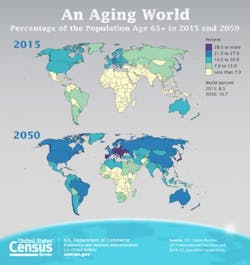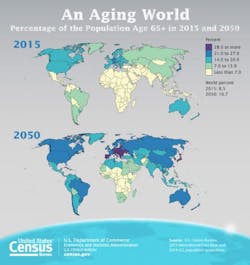And the global population trends highlighted by the Census Bureau only adds to the gloom.
To wit, America's 65-and-over population is projected to nearly double over the next three decades, ballooning from 48 million to 88 million by 2050.
Though the U.S. population will actually age at a slower rate compared with other countries, such as Japan, that’s cold comfort for trucking companies trying to fill empty seats and shop bays as the retirement rate picks up speed within the industry.
"The U.S. was the 48th oldest country out of 228 countries and areas in the world in 2015," noted Wan He, a demographer on population aging research at the Census Bureau. "Baby boomers began reaching age 65 in 2011 and by 2050 the older share of the U.S. population will increase to 22.1% (compared to 14.9% in 2015). However, the U.S. will fall to 85th because of the more rapid pace of aging in many Asian and Latin American countries."
Japan is the current oldest country in the world and will retain that position in 2050, he added, though South Korea, Hong Kong and Taiwan are projected to overtake Germany, Italy and Greece for second, third and fourth place by that time.
Here’s some of the other findings from the Census Bureau’s report:
- Worldwide, the 65-and-over population is expected to more than double to 1.6 billion by 2050.
- Some countries, including China, India, Indonesia, Brazil, Colombia and Cuba, will experience a quadrupling of their oldest-old population, those 80 and over, from 2015 to 2050.
- Asia is also notable for leading the world in the size of the older population with 341 million people 65 and older.
- On the other hand, Africa remained young in 2015, where only 3.5% of the total population was 65 and over.
- Labor force participation among the older population continues to rise in many developed countries, yet remains highest in low-income countries.
- A number of European countries and the U.S. are gradually increasing their age eligible to receive a full public pension to 67.
- More than 90% of the older population receives a pension in more developed countries, such as Japan, the U.S., Australia and Italy.
- In contrast, public pensions cover less than a third of the older population in China and 1/10th of those in India; two countries with a total population of more than a billion each.
- Global life expectancy at birth was 68.6 years in 2015 and is projected to rise to 76.2 years in 2050.
- The population age 80 and over has been growing faster than the population of people between ages 65 and 79 because of increasing life expectancy at older ages.
- Declining fertility levels have been the main propeller for population aging, although rates of fertility decline vary by region and country.
- Currently, the global fertility rate is near or below the 2.1 replacement level in all world regions except Africa.

